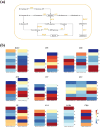Environmental drivers and transcriptomic variations shaping Lei bamboo shoots across cultivation regions
- PMID: 40235921
- PMCID: PMC11997477
- DOI: 10.3389/fpls.2025.1565665
Environmental drivers and transcriptomic variations shaping Lei bamboo shoots across cultivation regions
Abstract
The nutritional composition of bamboo shoots varies significantly across regions, yet the precise environmental drivers and underlying molecular mechanisms remain poorly understood. In particular, the influence of soil properties and climatic factors on key metabolic pathways regulating bamboo shoot quality has not been systematically examined. In this study, we investigate the environmental determinants of nutrient accumulation in Lei bamboo (Phyllostachys violascens) shoots by integrating environmental analysis, nutritional profiling, and transcriptomics. We identified soil organic matter, total porosity, and longitude as the primary factors influencing bamboo shoot nutrition, with higher soil organic matter correlating with enhanced nutrient content. Transcriptome analysis revealed that environmental conditions regulate key metabolic pathways, including starch metabolism (e.g., BGLU, SPS) and flavonoid biosynthesis (e.g., PAL, 4CL), ultimately shaping bamboo shoot quality. Based on these findings, we developed a predictive model linking environmental factors, gene expression, and nutritional traits, providing a foundation for precision cultivation strategies. This study provides novel insights into plant-environment interactions governing bamboo shoot nutrition and offers actionable strategies for region-specific cultivation, aligning with consumer demand for healthier bamboo-based products.
Keywords: bamboo shoots; environmental factors; nutritional traits; precision cultivation; regional management; transcriptome.
Copyright © 2025 Qian, Jia, Chen, Wang, Li, Gao, Ying and Shi.
Conflict of interest statement
The authors declare that the research was conducted in the absence of any commercial or financial relationships that could be construed as a potential conflict of interest.
Figures








References
-
- Acharya B., Behera A., Sahu P. K., Dilnawaz F., Behera S., Chowdhury B., et al. . (2023). Bamboo shoots: an exploration into its culinary heritage in India and its nutraceutical potential. J. Ethn Foods 10, 22. doi: 10.1186/s42779-023-00190-7 - DOI
-
- Aribal L., Parlucha J., Gelaga J., Aguinsatan R. (2022). Influence of abiotic factors on growth and development of giant bamboo (Dendrocalamus asper) in Bukidnon, Philippines. J. Trop. For Sci. 34, 63–73. doi: 10.26525/jtfs2022.34.1.63 - DOI
-
- Asante K. O.-H., Akoto D. S., Derkyi N. S. A., Abugre S. (2024). Advancing circular economy for the growth, root development and elemental characteristics of bamboo (Bambusa vulgaris) on galamsey-degraded soil. Adv. Bamboo Sci. 6, 100054. doi: 10.1016/j.bamboo.2023.100054 - DOI
-
- Bayram N. E., Gercek Y. C., Çelik S., Mayda N., Özkök A. (2021). Phenolic and free amino acid profiles of bee bread and bee pollen with the same botanical origin–similarities and differences. Arab J. Chem. 14, 103096. doi: 10.1016/j.arabjc.2021.103096 - DOI
-
- Bhattacharya A. (2022). “Effect of low-temperature stress on germination, growth, and phenology of plants: A review,” in Physiological processes in plants under low temperature stress (Singapore: Springer; ), 1–106. doi: 10.1007/978-981-16-9037-2_1 - DOI
LinkOut - more resources
Full Text Sources

